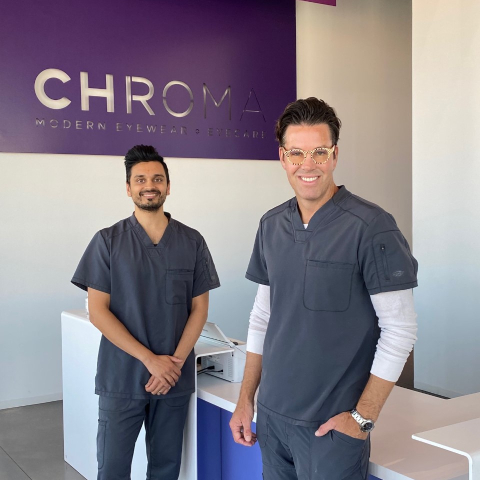Protecting Your Vision
With more than 4.2 million Americans aged 40 years or older classified as legally blind, supporting strong eye health and vision has never been more important. Eye diseases develop and affect patients in a variety of ways, sometimes without them even noticing at first.
Eye diseases can be caused by other health conditions, such as diabetes, certain lifestyles, or factors like age. It’s common for these diseases to show little to no warning signs as they start to damage the eye. This means regular eye exams are one of the only ways to identify eye disease early.

The Risk of Eye Diseases
Many forms of eye disease pose a serious risk to eye and vision health. Since the eye is made up of extremely delicate components, it can easily be damaged. Once damaged, patients may experience partial vision loss or complete blindness.
Areas that are often targeted by eye diseases include the:
To ensure your eye health and vision are getting the care they need, regular eye exams are crucial. If you have a health condition like diabetes, we recommend you come in for more frequent and specialized eye exams.
Common Eye Diseases
Although there are many different eye diseases, here are a few common ones to be aware of. If these conditions run in your family, it’s important to know you may be at risk of developing them.
Glaucoma
Glaucoma is a group of diseases that targets your eye’s optic nerve. As the optic nerve is responsible for transferring information from the retina to the brain, damage to the optic nerve can cause vision loss. Glaucoma is one of the leading causes of blindness in patients over 60.
It’s common for some kinds of glaucoma to show little to no symptoms as they develop. Regular eye exams are the best way to identify glaucoma early. If diagnosed early, glaucoma can be managed, limiting optic nerve damage and vision loss.
Age-Related Macular Degeneration
Age-related macular degeneration (AMD) is the most common cause of blindness in people over 60. The disease occurs when the eye’s macula (the central part of the retina) starts to wear down. There are 2 different types of AMD: wet and dry.
Dry AMD is caused by drusen deposits building up in the macula. As the deposits collect, they can make it hard for the eye to focus on objects clearly and can cause blind spots. Over time, patients with dry AMD can eventually lose their central vision.
Wet AMD most frequently occurs after dry AMD. This happens when blood vessels break under your macula and leak fluid into your retina. This fluid causes blurred vision and blindness.
Diabetic Retinopathy & Diabetic Macular Edema
Diabetic retinopathy is caused by the effects of diabetes on the eye’s blood vessels. As diabetes causes irregular blood sugar levels, the eye’s blood vessels may become blocked and break. If broken, they can leak fluid into the retina (diabetic retinopathy) and then into the macula (diabetic macular edema).
Our Brands









Come Visit Us

Our Address
- 1700 Montgomery Street
- Fort Worth, TX 76107
Contact Information
- Phone: 817-737-6281
- Text: 817-737-6281
- Email: [email protected]
HOURS
- Monday: 9:00 AM – 5:00 PM
- Tuesday: 9:00 AM – 5:00 PM
- Wednesday: 9:00 AM – 5:00 PM
- Thursday: 9:00 AM – 5:00 PM
- Friday: 9:00 AM – 5:00 PM
- Weekends: Closed
Our Testimonials
Great customer service, very nice employees and a great doctor. They will do what they can to make sure your needs are meet in the most efficient way.
Connor
Love love love Dr. Barber & all his staff! I’ve seen Dr. Barber at his previous location; this was my first visit to CHROMA though. Blew me away. The technology they’ve implemented led to the quickest & most thorough examination. I went initially for my routine exam & to purchase my yearly contacts. Welp- they had way too many cute pairs of glasses & since my prescription had GOTTEN BETTER, I needed new glasses too. I had NOT budgeted the money for both contacts & new glasses. They were so so accommodating: set aside + added the frames I liked to my file, calculated all the prices (with & without insurance for both), answered my million questions, etc etc. Ended up leaving with my exam + contacts + new glasses for the same amount I used to spend on just contacts for a year. Cannot WAIT to get my new cute glasses in a couple weeks! To summarize: GO SEE THEM! I just THOUGHT Dr. Barber had an awesome practice before moving. Now, he’s got the ABSOLUTE BEST you could ever imagine. ♥️
Lauren
I have just barely had glasses and been visiting Chroma for about a year now and it has been a great experience so far. They are very welcoming and you can tell how much they care for the patience. Top of the line equipment and top of the line service.
Kason
We love and adore Dr. V! He is personable, kind, and he knows his stuff! We drive 40 minutes to see him for our son. Staff was pleasant and went out of their way to help with insurance question. The building is super cool and modern. They have so many frame options in office which is super nice! Excellent experience!
Jenny
I absolutely love CHROMA! Dr. V and the entire staff is so amazing and I know I am receiving the best care with each visit! Everyone is extremely knowledgeable, professional, and so friendly!! Dr. V really takes the time to explain everything and also makes the appointment enjoyable! The office is SOOO stunning and clean as well!
Kelly
I’m always so so happy with my experience at Chroma. I live in New York and make sure I come back here every year because Dr Barber (and now Dr. V) really can’t be beat. They really take care of their patients from start to finish. I also appreciate how great the staff is at communication before and after appointments- they are very accommodating and helpful to work out the best deal for you. Bottom life- can’t beg you enough to go here for your eye care. You will never regret it.
Alexa
Our Blog
UV Protection vs. Polarized: What’s the Difference?
Frames & LensesEyeglasses are more than fashionable tools that help us to see the world around us, they can also protect our eyes against sun damage and reduce unwanted glare. UV […]
Do Glasses Help with Dry Eyes?
Dry EyeDry eyes can lead to irritation, discomfort, blurry vision, and can impact our overall quality of life. Fortunately, several treatment options are available to target the root cause of […]
How Do Multifocal Contact Lenses Work?
Contact LensesMultifocal contact lenses are a game-changer for those with presbyopia or other vision conditions that impair their ability to see at different distances. The first step in deciding if […]
UV Protection vs. Polarized: What’s the Difference?

Eyeglasses are more than fashionable tools that help us to see the world around us, they can also protect our eyes against sun damage and reduce unwanted glare. UV […]
Do Glasses Help with Dry Eyes?

Dry eyes can lead to irritation, discomfort, blurry vision, and can impact our overall quality of life. Fortunately, several treatment options are available to target the root cause of […]
How Do Multifocal Contact Lenses Work?

Multifocal contact lenses are a game-changer for those with presbyopia or other vision conditions that impair their ability to see at different distances. The first step in deciding if […]











